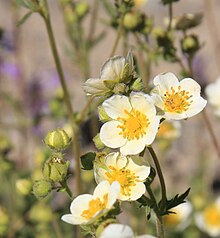Drymocallis glandulosa
| Drymocallis glandulosa | |
|---|---|

| |
| In Circle X Ranch Park, Santa Monica Mountains, California | |
| Scientific classification | |
| Kingdom: | Plantae |
| Clade: | Tracheophytes |
| Clade: | Angiosperms |
| Clade: | Eudicots |
| Clade: | Rosids |
| Order: | Rosales |
| Family: | Rosaceae |
| Genus: | Drymocallis |
| Species: | D. glandulosa
|
| Binomial name | |
| Drymocallis glandulosa (Lindl.) Rydb.
| |
| Synonyms | |
|
Potentilla glandulosa Lindl. | |

Drymocallis glandulosa, known by the common name sticky cinquefoil and formerly as Potentilla glandulosa, is a plant species in the family Rosaceae.
It is native to western North America from southwestern Canada through the far western United States and California, into Baja California.[1] It is widespread and can be found in many types of habitats.
Description[]
Drymocallis glandulosa is generally erect in form but it may be small and tuftlike, measuring just a few centimeters high, or tall and slender, approaching 1 metre (3.3 ft) in height. It may or may not have rhizomes.[2]
It is usually coated in hairs, many of which are glandular, giving the plant a sticky texture. The leaves are each divided into several leaflets, with one long terminal leaflet and a few smaller ones widely spaced on each side.
The inflorescence is a cyme of 2 to 30 flowers which are variable in color and size. Each has usually five petals up to a centimeter long which may be white to pale yellow to gold.
Varieties[]
It is highly variable and there are many varieties and subspecies, some of which intergrade and are not clearly defined. They include:[3]
- Drymocallis glandulosa var. glandulosa
- Drymocallis glandulosa var. reflexa
- Drymocallis glandulosa var. viscida
- Drymocallis glandulosa var. wrangelliana
Ecology[]
The plant is more common after its habitat is cleared or disturbed, such as by wildfire, clearcutting, or heavy grazing.[2]
It is an important food for several species of mice, including the western harvest mouse, cactus mouse, and California mouse.[2]
References[]
- ^ "Drymocallis glandulosa". Natural Resources Conservation Service PLANTS Database. USDA.
- ^ Jump up to: a b c Reeves, Sonja L. "Potentilla glandulosa". Fire Effects Information System (FEIS). US Department of Agriculture (USDA), Forest Service (USFS), Rocky Mountain Research Station, Fire Sciences Laboratory – via https://www.feis-crs.org/feis/.
- ^ "Drymocallis glandulosa". Calflora: Information on California plants for education, research and conservation. Berkeley, California: The Calflora Database – via www.calflora.org.
External links[]
 Media related to Drymocallis glandulosa at Wikimedia Commons
Media related to Drymocallis glandulosa at Wikimedia Commons- Jepson eFlora, The Jepson Herbarium, University of California, Berkeley
- Potentilla glandulosa in the CalPhotos photo database, University of California, Berkeley
- Drymocallis glandulosa in the CalPhotos photo database, University of California, Berkeley
- Drymocallis
- Baja California
- Flora of British Columbia
- Flora of California
- Flora of Idaho
- Flora of Montana
- Flora of Nevada
- Flora of Oregon
- Flora of Washington (state)
- Flora of the Cascade Range
- Flora of the Great Basin
- Flora of the Klamath Mountains
- Flora of the Sierra Nevada (U.S.)
- Natural history of the California chaparral and woodlands
- Natural history of the California Coast Ranges
- Natural history of the Peninsular Ranges
- Natural history of the San Francisco Bay Area
- Natural history of the Santa Monica Mountains
- Natural history of the Transverse Ranges